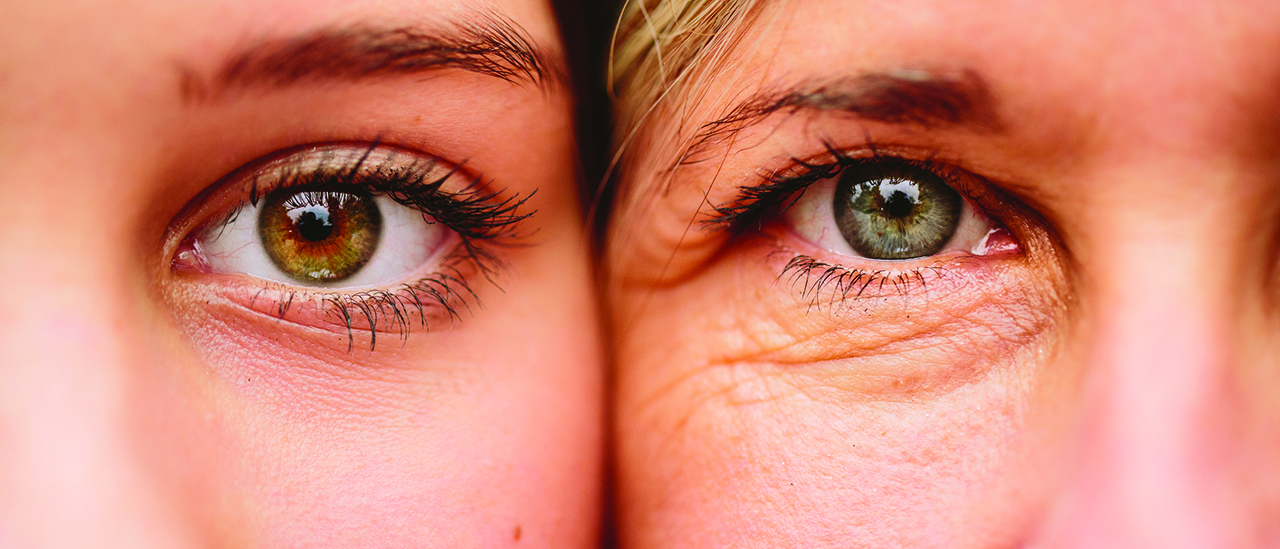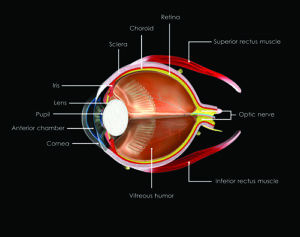
You can’t prevent many of the changes to your eyes that come with age, but you can protect your vision and reduce your risk of developing eye disease.
The eyes have it. Until they don’t.
For most of us, our eyes begin to show signs of aging in our mid-40s. From there, our vision deteriorates with every passing year. In each of our eyes, the pupil, which controls the amount of light entering our eyes, starts to shrink. The lens, which focuses the images we see onto the retina, stiffens and sometimes becomes cloudy. The retina, which collects the light projected by the lens and transmits it to the optic nerve, become less sensitive.
Age-related vision impairment can take many forms. We may become more near- or far-sighted. We may have a harder time distinguishing colours and shades. Our eyes can take longer to adjust to changing light levels, ie. when walking from a movie theatre out into a sunny parking lot. We suddenly need three times as much light to read comfortably as we did when we were in our 20s. We may produce fewer tears, resulting in redness and irritation. Far from a mere inconvenience, vision impairment can affect every aspect of daily living: reading, shopping, cooking, driving. If we ignore it, even slight loss of vision can lead to accidents and falls, resulting in injury or loss of independence.
While you can’t prevent many of the changes to your eyes that come with age, you can protect your vision and reduce your risk of developing eye disease. As our age increases, so does our vulnerability to such diseases. While some conditions are easy to fix, others (we’re looking at you, glaucoma) can appear without warning and lead to irreversible blindness.
That’s one of the reasons why the Manitoba Association of Optometrists recommends having your eyes examined once a year. “During a standard eye exam your optometrist will check for changes to your visual acuity and visual field, and for signs of eye disease. Other general health concerns, such as diabetes or tumours, can often be detected during an eye exam. While some eye diseases cannot be reversed, early detection is always important for the best treatment options to slow or limit progression of a disease.”
Eye Problems, A-Z

Age-related macular degeneration (AMD) affects the macula (the back part of the eye), causing blurriness or loss of vision at the centre of your field of view, while leaving side or peripheral vision unaffected.
AMD is the leading cause of blindness in North American adults over the age of 55. While vision lost to AMD cannot be recovered, treatments and lifestyle changes (including exercise, wearing sunglasses, and taking special vitamin supplements) can slow progression of the disease. You can help prevent AMD by wearing UV protection, keeping your blood pressure down, eating well, and getting regular eye exams—especially if AMD runs in your family.
Cataracts are cloudy areas that form on the lens. By age 75, more than half of us will develop cataracts. Many remain small and don’t cause much of a problem, but larger ones cause blurry vision, difficulty seeing at night, colours that look faded, haloes, and lights that seem too bright. Cataract surgery, the usual treatment, is safe and common.
Conjunctivitis is when the tissue that covers your eye gets inflamed. Also called pink eye or red eye, conjunctivitis is often caused by bacteria and viruses, or allergens and irritants getting into the eye. Treatment depends entirely on the cause.
Dry eye occurs when your eyes don’t produce enough tears, or produce tears that have the wrong chemical composition. Symptoms include blurry vision, eye fatigue, headaches, and burning/itchy eyes. Dry eyes can lead to loss of vision, so see your eye doctor, who will probably treat the condition with a humidifier or eye drops. In extreme cases, you may need tear duct plugs or surgery.
Floaters are those tiny ghost-like spots that drift across your field of view. You notice them most in a bright room or on a sunny day. They’re perfectly normal, but if they come on suddenly accompanied by flashes of light, you may be dealing with a detached retina—a medical emergency that requires an immediate visit to your doctor.
Glaucoma is a family of progressive diseases caused by damage to the optic nerve, which can lead to blindness if left untreated. Symptoms of glaucoma may include a loss of peripheral vision to one or both eyes. Regular eye exams check for pressure buildup in the tissues of the eye. Glaucoma can be hereditary; diabetes and other conditions may increase your risk. Treatment includes prescription eye drops or laser surgery.
Presbyopia is when you can’t see close objects or small print clearly. The culprit? Age-related stiffening and clouding of the eye’s lens. The lens hardens with age, but changes may take decades to notice. Glasses or contacts often restore impaired vision.
For more about age-related problems and diseases of the eyes, visit the Manitoba Association of Optometrists website at www.mb-opto.ca

Look here! Tips for healthy eyes and vision
- Increase lighting levels, especially for close tasks.
- Wear sunglasses that provide 100% UVA and UVB protection. UV exposure can contribute to the development of age-related eye diseases.
- Be aware of changes or limitations in your peripheral vision while walking outside or driving.
- Get regular eye exams.
- Wear the eyewear prescribed for you. You may need to use reading glasses, progressives, or bifocals to compensate for presbyopia. Multifocal contact lenses are also available.
Recent News

Embracing Hope: The Impact of DLC’s Movement Disorder Clinic

Winnipeg Jets Parkinson’s Disease Awareness Game!


